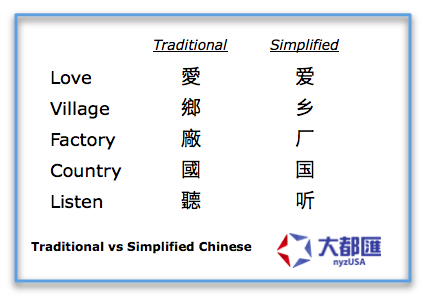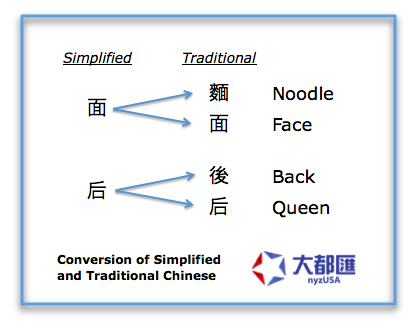Traditional and Simplified Chinese
Unlike English, Chinese words are not composed by a small number of alphabets. Rather, they are in forms of picture-like characters. There are tens of thousands of Chinese characters in Chinese language*. About four thousand of them are used in everyday life now.
There are two forms of characters in Chinese language: traditional and simplified. Simplified character forms were created in the late 20th century by decreasing the number of strokes and simplifying the forms of a sizable proportion of traditional Chinese characters.

Traditional Chinese characters are currently used in Taiwan, Hong Kong and Macau. While traditional characters can still be read and understood by many mainland Chinese, Singaporeans and Malaysians, these groups generally retain their use of Simplified characters.
So, which form should you use in the U.S.?
In general, overseas Chinese communities tend to use traditional characters. Major Chinese newspapers in the United States targeting all Chinese are all in traditional Chinese. However, media that primarily target mainland Chinese immigrants are in simplified Chinese.
Most of the websites that serve Chinese from various origins offer both traditional and simplified forms. It doesn’t require additional translation or data storage. Each traditional character has its corresponding simplified or unchanged form. Thus, content can be stored in traditional form; and the system can convert it to simplified form if website visitors choose to view in simplified Chinese.
Do NOT do the opposite though. Many simplified characters represent more than one traditional characters. Therefore, the reverse does not always convert right.

How about printed materials?
That depends on your target audience and the nature of the content. When all eyes are in China, people would naturally think simplified Chinese is the way to go. Nevertheless, if the material is intended for the larger Chinese audience overseas, traditional Chinese should be considered seriously. Any decorative contexts such as shop signs and calligraphy should always be in traditional Chinese.
It is okay, but most of the time unnecessary to print material in both forms side by side. Just make sure not to have it half and half, for example having the headline in traditional and the body in simplified or vice versa. That would be very unprofessional.
* Chinese characters are adopted by Japanese, Korean and Vietnamese. There are less characters are used in those languages.
